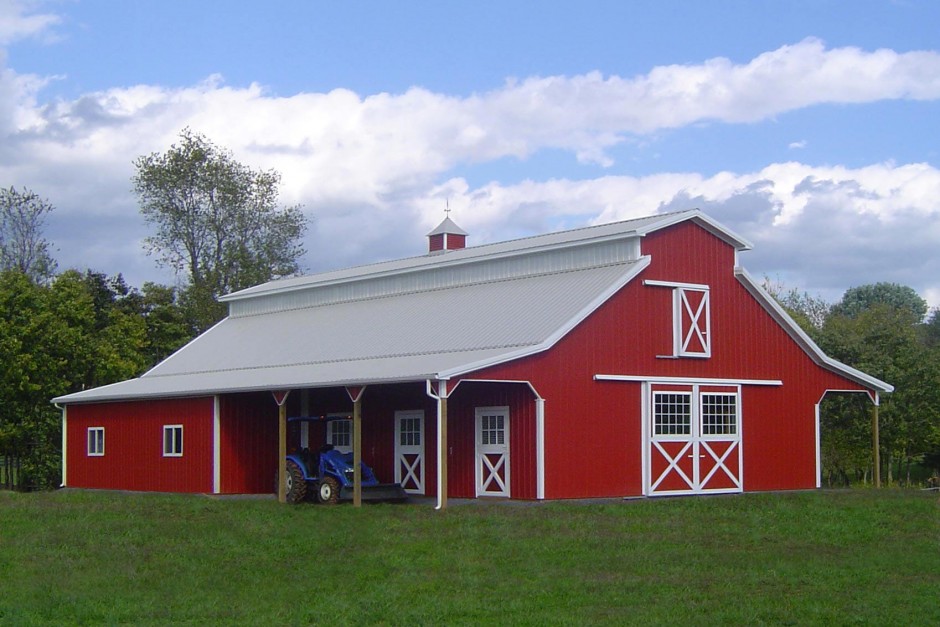Painting Barns, Why are Barns Traditionally Painted Red?
I wrote a post earlier today about treating wood used to build vegetable garden planters, and in my post I had mentioned beeswax and milk paint. Milk Paint has been around for centuries, it was even found in Tutankhamen's tomb when it was opening in 1924. This post will reveal what farmers did way back in the day when building their Barns and why, they seem to traditionally are red.

Way back then, farmers where very frugal people, and learned to be creative with all that they had at their disposal. Farmers were looking for ways to protect the wood that their barns were built of. So in experimenting they discovered a method that seems to have worked. What was the one thing that farmers had around the farm that was in excess supply, Milk. So the farmers started experimenting with a milk mixture.
A recipe including skimmed milk, lime and a red iron oxide was tested. This cheap to make mixture was proven to last a long time on the farmers barns. Farmers found easily iron oxide in the soil. The natural reddish color of the clay based soil was used.Farmers also grew Flax plants which they obtained the Linseed oil. This combination created a dark coral hue stain. The Farmers found that with the darker walls it created a warmer environment inside the barns as the wood absorbed the sun light, which was great for the colder winter months.

Some say that Farmers used Rust in the milk, lime, Linseed mix which gave that reddish color. They felt that rust was found all around the homestead and was used because it killed fungi and many of the mosses that might grew on barns.
Today Paint has come a long way in its compound and mixture, however the tradition of using the color red on barns and farms is still used in honor of the tradition.
Just a post with a tid bit of history.

Image Source:
http://fival.info/red-barn-pictures/
https://www.trendir.com/red-exterior-homes/
You received a 10.0% upvote since you are not yet a member of geopolis.
To read more about us and what we do, click here.
https://steemit.com/geopolis/@geopolis/geopolis-the-community-for-global-sciences-update-2-higher-base-votes-new-logo
If you do not want us to upvote and comment on your posts concerning earth and earth sciences, please reply stop to this comment and we will no longer bother you with our love ❤️
Love this! How cool! I never knew that! Now I kinda wanna find a recipe for it and paint my own... well I don't have a barn but maybe my chicken coop (;
Glad I found your post! Following you now ( :
Lots of recipes out there, skimmed milk, lime, mineral oil or jojoba oil.
I love history—the best stories are the ones that really happened! Thanks for writing this post!
your welcome
Love those older barns. We have a ton around here.
Another day, another fascinating tidbit of knowledge. Thanks, OP!
I thought thought the were red so they could be seen from space... I enjoyed the read, we need more of this natural product awareness in circulation. Thanks for spreading info.
Very interesting I have had zero experience with milk paint and have learned something new. Thanks
Apparently it is a good long lasting paint, but I believe it is the drying time so you would need at least 3 days of no precipitation to ensure it wont wash away. That was the challenge for those farmers back in the day.
I really enjoyed reading this, I am still hoping for a red barn of my very own. For now I'll just keep painting other things red :)
We've had great success using milk paint both indoors and out. It's standing up really well on our outbuildings and on the furniture that I've painted. The milk paint that I've been buying contains milk protein (casein), limestone, clay, chalk and natural non-toxic pigments made from iron oxides. It's amazing stuff especially if you want to avoid the use of paints that emit unhealthy fumes. I know some of the more trendy "milk paint" products aren't really holding to the traditional recipes anymore.
I'm interested in using slaked lime and water in the spring to paint the inside of the chicken coop. I've read that this has antibacterial properties. I would love to know if anyone else does this and what they think.
You can make your own Milk Paint, using skimmed milk, mineral oil or jojoba oils, rust or red sand, and lime. There are a bunch of good website that have the recipes. Give that a go. I don't know much about slaked lime for painting. Sorry. Thanks for reading.
I have always wondered, and now I know.... thank you for the fun facts!
https://steemit.com/minnowsupport/@torico/torico-s-sustainability-curation-2018